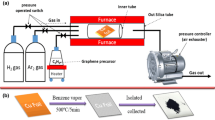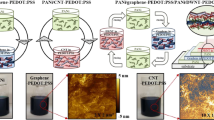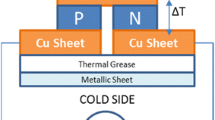Abstract
In this paper, fabrication and characterization of Cu/PTB7-Th (35 mass%)/PC\(_{61}\)BM (35 mass%)/graphene (30 mass%)/Ag thin-film composite cells are given. First of all, Ag and Cu electrodes were deposited on flat glass substrate by vacuum evaporation with 130-\(\upmu \)m inter-electrode gap. The PTB7-Th (35 mass%) composite and PC\(_{61}\)BM (35 mass%) composite in chlorobenzene and graphene (30 mass%) were deposited on the inter-electrode gap by drop-casting technique, and film thickness of 8–12 \(\upmu \)m was achieved. The dependence of forward and reverse bias resistance of the cells versus temperature in the range of 25–75 \({^{\circ }}\)C, humidity in the range of 47–90 %RH and pressure in the range of 0–7.7 kN m\(^{-2}\) was measured. The average temperature resistance coefficients were equal to (− 1.03)% \({^{\circ }}\hbox {C}^{-1}\) and \((-\,1.14)\%\ {^{\circ }}\hbox {C}^{-1}\) for forward and reverse bias resistances, respectively. The reverse and forward bias resistances decreased 1.29 and 1.27 times due to \(\%\mathrm{RH}\), and due to pressure, it decreased by 9.0–9.2%. Impedance (Z) of the sample was also measured at different frequencies (100 Hz, 1 kHz, 10 kHz and 100 kHz) which decreased from 1.23 to 1.04 times. The obtained results are explained, firstly, by transfer of charges between donors and acceptors molecules and effect of water molecules on the PTB7-Th (35 mass%):PC\(_{61}\)BM (35 mass%):graphene composite.










Similar content being viewed by others
References
Li Y, et al. Fluorine-induced highly reproducible resistive switching performance: facile morphology control through the transition between J- and H-aggregation. ACS Appl Mater Interfaces. 2017;9(11):9926–34.
Wang J-T, et al. Stretchable conjugated rodcoil poly (3-hexylthiophene)-block-poly (butyl acrylate) thin films for field effect transistor applications. Macromolecules. 2017;50(4):1442–52.
Wood S, Hollis JR, Kim J-S. Raman spectroscopy as an advanced structural nanoprobe for conjugated molecular semiconductors. J Phys D Appl Phys. 2017;50(7):073001.
He Z, et al. Single-junction polymer solar cells with high efficiency and photovoltage. Nat Photon. 2015;9(3):174.
Petraki F, Papaefthimiou V, Kennou S. The electronic structure of Ni-phthalocyanine/metal interfaces studied by X-ray and ultraviolet photoelectron spectroscopy. Organ Electron. 2007;8(5):522–8.
Lee CW, Kim OY, Lee JY. Organic materials for organic electronic devices. J Ind Eng Chem. 2014;20(4):1198–208.
Tye RP, Gardner RL, Maesono A. Temperature measurement and control. J Therm Anal Calorim. 1993;40:1009–16.
Dhurandher BK, et al. Investigation of thermal equilibrium in a compartment involving crib fire. J Therm Anal Calorim. 2017;129(3):1787–97.
Nazoktabar M, Arshtabar K, Mohammadkhani H. Investigating the effect of coolants heat transfer type on thermostat placement. J Therm Anal Calorim. 2020;139:2519–26.
Yi F, Friedman LH, Chen R, LaVan DA. Sample pattern and temperature distribution in nanocalorimetry measurements. J Therm Anal Calorim. 2019;138(5):3367–73.
Li Q, et al. Review of flexible temperature sensing networks for wearable physiological monitoring. Adv Healthc Mater. 2017;6(12):1601371.
Sadasivuni KK, et al. Reduced graphene oxide filled cellulose films for flexible temperature sensor application. Synth Metals. 2015;206:154–61.
Takei K, et al. Toward flexible and wearable humaninteractive healthmonitoring devices. Adv Healthc Mater. 2015;4(4):487–500.
Yokota T, et al. Ultraflexible, large-area, physiological temperature sensors for multipoint measurements. Proc Natl Acad Sci. 2015;112(47):14533–8.
Zhang Y, et al. Theoretical and experimental studies of epidermal heat flux sensors for measurements of core body temperature. Adv Healthc Mater. 2016;5(1):119–27.
Li G, Zhu R, Yang Y. Polymer solar cells. Nat Photon. 2012;6(3):153.
Liao SH, et al. Fullerene derivative doped zinc oxide nanofilm as the cathode of inverted polymer solar cells with low bandgap polymer (PTB7Th) for high performance. Adv Mater. 2013;25(34):4766–71.
Li N, Brabec CJ. Air-processed polymer tandem solar cells with power conversion efficiency exceeding 10 percent. Energy Environ Sci. 2015;8(10):2902–9.
Liao S-H, et al. Single junction inverted polymer solar cell reaching power conversion efficiency 10.31% by employing dual-doped zinc oxide nano-film as cathode interlayer. Sci Rep. 2014;4:6813.
Luo B, et al. Colorful flexible polymer tandem solar cells. J Mater Chem C. 2017;5(31):7884–9.
Nam S, et al. Inverted polymer fullerene solar cells exceeding 10% efficiency with poly (2-ethyl-2-oxazoline) nanodots on electron-collecting buffer layers. Nat Commun. 2015;6:8929.
Wang J, et al. FAPbCl\(_3\) perovskite as alternative interfacial layer for highly efficient and stable polymer solar cells. Adv Electron Mater. 2016;2(11):1600329.
Aziz F, et al. Influence of humidity conditions on the capacitive and resistive response of an Al/VOPc/Pt co-planar humidity sensor. Measur Sci Technol. 2011;23(1):014001.
Brütting W. Physics of organic semiconductors. New York: Wiley; 2006.
Brabec CJ, Dyakonov V, Parisi J, Sariciftci NS, editors. Organic photovoltaics: concepts and realization. Heidelberg: Springer; 2003.
Wan Q, et al. 10.8% Efficiency polymer solar cells based on PTB7Th and PC71BM via binary solvent additives treatment. Adv Funct Mater. 2016;26(36):6635–40.
Farahani H, Wagiran R, Hamidon MN. Humidity sensors principle, mechanism, and fabrication technologies: a comprehensive review. Sensors. 2014;14(5):7881–939.
Karimov KS, et al. Ag/PEPC/NiPc/ZnO/Ag thin film capacitive and resistive humidity sensors. J Semicond. 2010;31(5):054002.
Fernandes L, et al. Thermal stability of low-bandgap copolymers PTB7 and PTB7-Th and their bulk heterojunction composites. Polym Bull. 2018;75(2):515–32.
Irwin JD, Wu C-H. Basic engineering circuit analysis. New York: Wiley; 1999.
Khan SB, et al. Impedimetric sensing of humidity and temperature using CeO\(_2\)Co\(_3\)O\(_4\) nanoparticles in polymer hosts. Microchim Acta. 2015;182(11–12):2019–26.
Acknowledgements
The authors are grateful to the GIK Institute of Engineering Sciences and Technology, Topi, Swabi, Khyber Pakhtunkhwa 23640, for supporting this work and providing the necessary research facilities.
Author information
Authors and Affiliations
Corresponding author
Additional information
Publisher's Note
Springer Nature remains neutral with regard to jurisdictional claims in published maps and institutional affiliations.
Rights and permissions
About this article
Cite this article
Karimov, K.S., Riaz, M. & Nabi, JU. Effect of temperature, humidity and pressure on electric properties of the cells based on PTB7-Th, PC61BM and graphene composite. J Therm Anal Calorim 143, 3033–3038 (2021). https://doi.org/10.1007/s10973-020-09467-4
Received:
Accepted:
Published:
Issue Date:
DOI: https://doi.org/10.1007/s10973-020-09467-4




